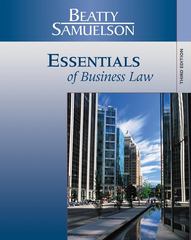Question
5. According to the H-O theory, trade reduces international differences in: a. commodity prices b. in factor prices c. both commodity and factor prices d.
5. According to the H-O theory, trade reduces international differences in:
a. commodity prices
b. in factor prices
c. both commodity and factor prices d. neither relative nor absolute factor prices
6. According to the Stolper-Samuelson theorem, international trade leads to
a. reduction in the real income of the nation's relatively abundant factor b. reduction in the real income of the nation's relatively scarce factor
c. increase in the real income of the nation's relatively scarce factor
d. none of the above
7. Which of the following is false with regard to the specific factors theorem, international trade
a. harms the immobile factors that are specific to the nation's export commodities or sectors
b. harms the immobile factors that are specific to the nation's import-competing commodities
c. has an ambiguous effect on the nation's mobile factors
d. may benefit or harm the nation's mobile factors
8. Perfect international mobility of factors of production
a. leads to a reduction in international differences in the returns to homogenous factors
b. acts as a substitute for international trade in its effects on factor prices
c. operates on the supply of factors in affecting factor prices d. all of the above
9. The Leontief paradox refers to the empirical finding that U.S.
a. import substitutes were more K-intensive than exports
b. exports were more L-intensive than imports
c. exports were more K-intensive than import substitutes
d. all of the above
10. From empirical studies, we conclude that the H-O theory:
a. must be rejected
b. must be accepted without reservations c. can generally be accepted
d. explains all international trade
11. International trade can be based on economies of scale even if both nations have identical:
a. factor endowments
b. tastes
c. technology d. all of the above
12.A great deal of international trade:
a. is intra-industry trade
b. involves differentiated products
c. is based on monopolistic competition d. all of the above
13. Intra-industry trade takes place:
a. because products are homogeneous b. in order to take advantage of economies of scale
c. because perfect competition is the prevalent form of market organization
d. all of the above
14. Which of the following statements is true with regard to the product-cycle theory?
a. it depends on differences in technological changes over time among countries
b. it depends on the opening and the closing of technological gaps among countries
c. it postulates that industrial countries export more advanced products to less advanced countries
d. all of the above
15. Transport costs:
a. increase the price in the importing country
b. reduces the price in the exporting country
c. falls less heavily on the nation with the more elastic demand and supply curves of the traded commodity
d. all of the above
Step by Step Solution
There are 3 Steps involved in it
Step: 1

Get Instant Access to Expert-Tailored Solutions
See step-by-step solutions with expert insights and AI powered tools for academic success
Step: 2

Step: 3

Ace Your Homework with AI
Get the answers you need in no time with our AI-driven, step-by-step assistance
Get Started


